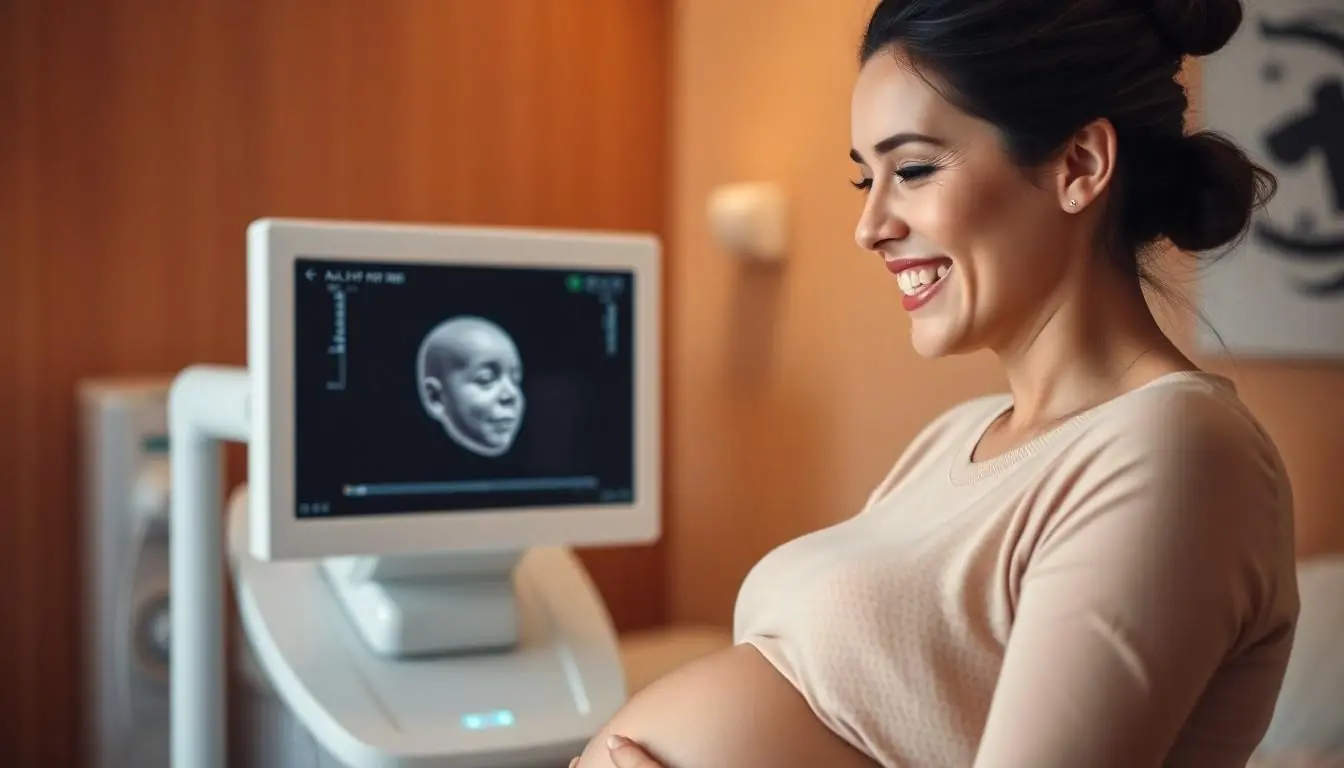Expecting a little one? Get ready to meet your baby before they even make their grand entrance! 3D pregnancy ultrasounds are like peeking behind the curtain of the womb, offering stunning images that make you feel like a VIP at your baby’s first photo shoot. Gone are the days of grainy black-and-white images; now, parents can marvel at their tiny human’s adorable features, from button noses to little fingers.
But it’s not just about the cute factor. These advanced ultrasounds provide crucial insights into the baby’s development and health. Imagine the joy of seeing your baby smile or yawn in real-time—it’s like having a front-row seat to the world’s cutest show! So buckle up for a journey into the fascinating world of 3D ultrasounds, where technology meets the miracle of life, and every heartbeat tells a story.
Table of Contents
ToggleOverview Of 3D Pregnancy Ultrasound
3D pregnancy ultrasounds offer expectant parents a remarkable opportunity to observe the intricate details of their unborn child. These advanced imaging techniques create vivid three-dimensional images, significantly enhancing the emotional experience of pregnancy.
What Is 3D Pregnancy Ultrasound?
3D pregnancy ultrasound is a diagnostic imaging tool that produces realistic images of a fetus. This technology captures images by sending sound waves through the body, creating a three-dimensional representation of the baby’s features. Unlike traditional 2D ultrasounds, 3D ultrasounds provide depth perception and texture, allowing parents to see their baby’s face and movements in unprecedented clarity. Many clinics use this technology during the second and third trimesters to assess fetal development.
How Does 3D Ultrasound Work?
3D ultrasound operates by emitting high-frequency sound waves. These sound waves bounce off the fetus and internal structures, then return to the ultrasound machine. A computer processes the returning echoes and translates them into three-dimensional images. Operators position the transducer at various angles to capture multiple views of the fetus. Each view is then compiled to create an accurate three-dimensional representation. Typically, the procedure lasts between 20 to 45 minutes.
Benefits Of 3D Pregnancy Ultrasound

3D pregnancy ultrasounds offer numerous advantages over traditional imaging methods. Enhanced imaging quality stands out, providing detailed and realistic views of the fetus.
Enhanced Imaging Quality
Enhanced imaging quality allows parents to see their baby’s features with remarkable clarity. Depth perception and texture create lifelike representations, making it easier to identify facial characteristics. Detailed images reveal potentially critical aspects of fetal anatomy that standard 2D ultrasounds might miss. Additionally, scanning techniques used generate images that can reveal the baby’s position and movements, providing essential insights into development. Parents often express amazement at the advanced technology’s ability to produce such vivid images.
Emotional Connection For Parents
Emotional connection for parents significantly increases with 3D ultrasounds. Seeing their baby’s facial expressions, such as smiling or yawning, fosters a deeper bond. The experience of watching the baby move in real-time invokes strong feelings and excitement. Parents report that these images facilitate early connections and make the pregnancy feel more tangible. This emotional engagement can also lead to increased anticipation for the arrival of the new family member. Many expectant parents treasure these moments, capturing them in keepsakes and memories.
Risks And Considerations
3D pregnancy ultrasounds offer numerous benefits, yet certain risks and considerations exist. Expectant parents must remain informed about these aspects to make educated decisions.
Safety Concerns
Safety during ultrasound procedures is a primary concern. Ultrasounds, including 3D versions, utilize sound waves, which are generally deemed safe, but prolonged exposure can be a concern. The American Institute of Ultrasound in Medicine advises limiting unnecessary ultrasound duration. Medical professionals typically recommend only using ultrasounds for necessary diagnostic purposes. Therefore, ensuring the procedure occurs in a clinical setting with trained personnel further mitigates risks.
When To Avoid 3D Ultrasound
Specific situations warrant avoiding 3D ultrasounds. If a patient experiences certain medical conditions, like placenta previa or significant health issues, consulting healthcare providers before proceeding is essential. Additionally, if previous ultrasounds indicate potential complications, a doctor may suggest postponing elective 3D imaging. Also, when performing ultrasounds primarily for entertainment, it’s prudent to reconsider, as medical professionals prioritize the health and safety of both mother and fetus above all.
Comparison With Other Imaging Techniques
3D pregnancy ultrasounds stand apart from other imaging methods, especially when comparing them to traditional techniques.
2D vs. 3D Ultrasound
2D ultrasounds generate flat images, often appearing grainy and lacking depth. In contrast, 3D ultrasounds offer detailed three-dimensional views of the fetus, showcasing intricate facial features and movements. Expectant parents experience the difference firsthand as they can visualize their baby’s expressions, like smiles or yawns. Clarity in imaging significantly enhances the understanding of fetal anatomy throughout pregnancy.
4D Ultrasound Explained
4D ultrasounds build upon the foundation of 3D technology by adding real-time motion. This advanced imaging captures not only static images but also dynamic movements, providing a live video experience of the fetus. Expecting families often find this immersive view particularly captivating, as they can watch their baby move, kick, or interact within the womb. While both 3D and 4D ultrasounds enhance parental bonding, the 4D option delivers an engaging and memorable experience.
3D pregnancy ultrasounds offer a remarkable opportunity for expectant parents to connect with their unborn child. With enhanced imaging quality and the ability to capture real-time movements, these ultrasounds transform the pregnancy experience into something truly special. Parents can witness their baby’s features and actions in stunning detail, fostering a deeper emotional bond.
While the technology provides invaluable insights into fetal development, it’s vital to prioritize safety and ensure these procedures are performed by qualified professionals. By balancing the excitement of seeing their baby with responsible practices, parents can fully embrace this incredible journey into parenthood.


